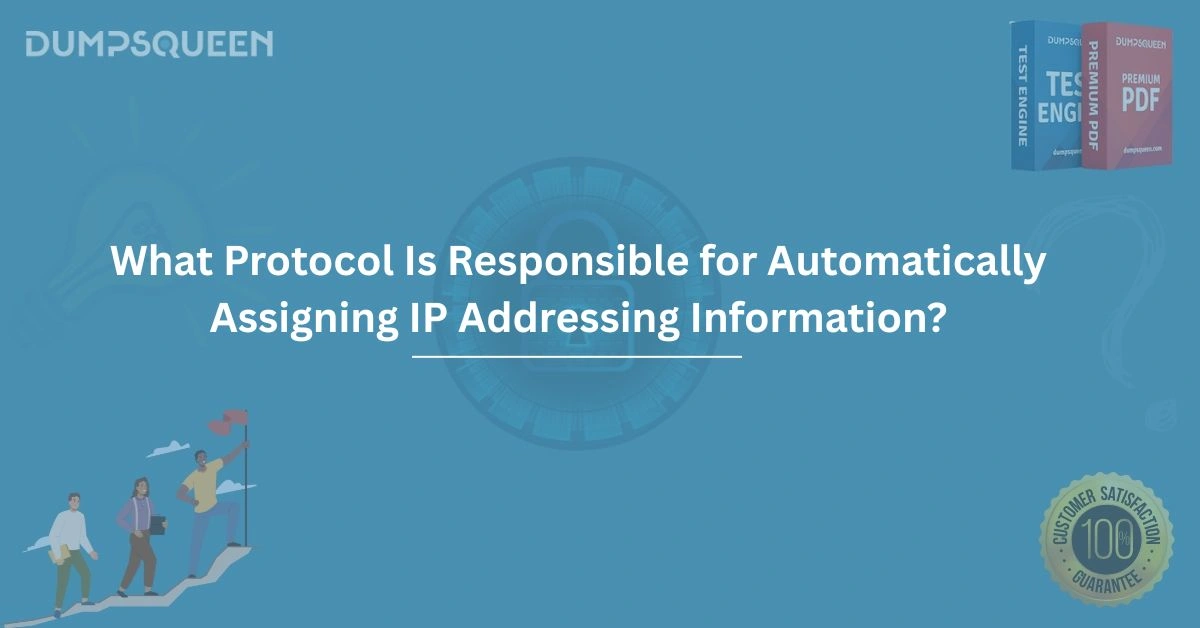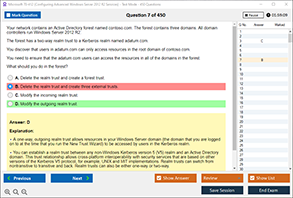Introduction
In the ever-evolving world of networking, the seamless assignment of IP addresses is a cornerstone of efficient communication between devices. Whether you're managing a small home network or a large enterprise infrastructure, the ability to automatically assign IP addressing information eliminates manual configuration errors and saves valuable time. The protocol responsible for this critical task is the Dynamic Host Configuration Protocol (DHCP). This Exam Prep Study Guide, brought to you by DumpsQueen, delves into the intricacies of DHCP, exploring its functionality, benefits, and importance in modern networking. By understanding DHCP, IT professionals and students preparing for certification exams can master a fundamental concept that underpins network operations. Visit DumpsQueen for comprehensive resources to enhance your networking knowledge and excel in your certification journey.
What is DHCP and Why Does It Matter?
The Dynamic Host Configuration Protocol (DHCP) is a network management protocol used to automate the assignment of IP addresses and other network configuration parameters to devices on a network. Without DHCP, network administrators would need to manually assign IP addresses to each device, a process that is not only time-consuming but also prone to errors, especially in large networks. DHCP simplifies this by dynamically allocating IP addresses from a predefined pool, ensuring that devices can connect to the network effortlessly.
DHCP operates on a client-server model, where the DHCP server maintains a database of available IP addresses and configuration details, while clients (such as computers, smartphones, or IoT devices) request this information. This automation is vital for scalability, as it allows networks to accommodate new devices without requiring constant manual intervention. For IT professionals studying for certifications like CompTIA Network+, Cisco CCNA, or Microsoft Azure, understanding DHCP is essential, as it frequently appears in exam objectives. DumpsQueen Exam Prep Study Guides provide targeted resources to help you grasp DHCP concepts and apply them in real-world scenarios.
How DHCP Works: The DORA Process
To fully appreciate how DHCP automates IP address assignment, it’s important to understand the four-step process known as DORA: Discover, Offer, Request, and Acknowledge. This process outlines the interaction between a DHCP client and server when a device joins a network.
When a device connects to a network, it sends a DHCP Discover message, a broadcast packet seeking available DHCP servers. This message essentially asks, “Is there a DHCP server that can provide me with an IP address?” Multiple servers may respond, depending on the network configuration, with a DHCP Offer message. This offer includes an available IP address, lease duration, subnet mask, default gateway, and other parameters like DNS server addresses.
The client evaluates the offers and selects one by sending a DHCP Request message, formally requesting the offered IP address. Finally, the server confirms the assignment with a DHCP Acknowledge message, finalizing the lease and allowing the client to use the IP address for network communication. This streamlined process ensures that devices receive unique IP addresses without conflicts. For those preparing for networking exams, mastering the DORA process is critical, and DumpsQueen offers practice questions and study materials to reinforce this knowledge.
Key Components of DHCP
DHCP’s functionality relies on several key components that work together to ensure smooth IP address allocation. The DHCP server is the central element, responsible for managing the pool of IP addresses and responding to client requests. In larger networks, multiple DHCP servers may be deployed for redundancy and load balancing, a concept known as DHCP failover.
The IP address pool is another critical component, defining the range of addresses available for assignment. Administrators configure this pool to avoid conflicts with statically assigned addresses, such as those used by servers or printers. The lease duration, which determines how long a device can use an assigned IP address, is also a key factor. Shorter lease durations are ideal for dynamic environments with frequent device changes, while longer leases suit stable networks.
Additionally, DHCP provides optional configuration parameters, such as the subnet mask, default gateway, and DNS server addresses, which are essential for proper network connectivity. These components collectively enable DHCP to adapt to various network sizes and requirements. DumpsQueen Exam Prep Study Guides break down these components in detail, helping candidates understand their roles in DHCP operations and prepare for certification success.
Benefits of Using DHCP in Network Management
The adoption of DHCP brings numerous advantages to network management, making it a preferred choice for organizations of all sizes. One of the primary benefits is time efficiency. By automating IP address assignment, DHCP eliminates the need for manual configuration, allowing administrators to focus on other critical tasks. This is particularly valuable in large networks with hundreds or thousands of devices.
DHCP also enhances network scalability. As new devices join the network, DHCP dynamically allocates IP addresses without requiring pre-configuration, supporting rapid expansion. This flexibility is crucial for modern networks that incorporate mobile devices, IoT gadgets, and virtual machines.
Another significant advantage is the prevention of IP address conflicts. Since DHCP ensures that each device receives a unique IP address from the pool, the risk of duplicate addresses—a common issue in manual configurations—is virtually eliminated. Furthermore, DHCP’s lease system allows addresses to be reused once devices disconnect, optimizing resource utilization.
For students and professionals aiming to validate their networking skills, understanding these benefits is key to answering exam questions about DHCP’s practical applications. DumpsQueen provides real-world scenarios and practice tests to help you internalize these concepts and excel in your studies.
DHCP in Modern Networking Environments
As networking technologies evolve, DHCP remains a cornerstone of both traditional and modern infrastructures. In enterprise networks, DHCP is often integrated with other protocols, such as DNS, to provide seamless name resolution and IP address management. For example, DHCP servers can update DNS records dynamically through a process called Dynamic DNS (DDNS), ensuring that device names and IP addresses remain synchronized.
In cloud computing environments, DHCP plays a vital role in virtualized networks. Cloud platforms like AWS, Azure, and Google Cloud rely on DHCP to assign IP addresses to virtual machines and containers, enabling rapid deployment and scalability. Similarly, in wireless networks, DHCP supports the dynamic assignment of IP addresses to mobile devices, ensuring uninterrupted connectivity as users move between access points.
The rise of IPv6, the next-generation Internet Protocol, has also influenced DHCP’s evolution. While IPv6 supports stateless address autoconfiguration (SLAAC), DHCPv6 provides a stateful alternative for environments requiring centralized control over IP address assignments. IT professionals preparing for advanced certifications, such as Cisco CCNP or CompTIA Network+, must understand these modern applications of DHCP. DumpsQueen Exam Prep Study Guides offer up-to-date resources to help you stay ahead in this dynamic field.
Common DHCP Challenges and Solutions
While DHCP is highly effective, it’s not without challenges. One common issue is DHCP server failure, which can disrupt IP address assignment and prevent devices from connecting to the network. To mitigate this, organizations often deploy redundant DHCP servers or use DHCP failover configurations to ensure continuous operation.
Another challenge is IP address exhaustion, which occurs when the IP address pool is fully allocated, leaving no addresses for new devices. Administrators can address this by expanding the address pool, shortening lease durations, or implementing network segmentation to distribute devices across multiple subnets.
Security is also a concern, as rogue DHCP servers can disrupt network operations by assigning incorrect IP addresses. To prevent this, organizations can implement DHCP snooping, a security feature that filters unauthorized DHCP messages. These challenges highlight the importance of proper DHCP configuration and monitoring, topics frequently covered in networking certification exams. DumpsQueen provides detailed guides and practice questions to help you master these concepts and tackle exam scenarios with confidence.
Preparing for Certification Exams with DHCP Knowledge
DHCP is a fundamental topic in many IT certification exams, including CompTIA Network+, Cisco CCNA, Microsoft Azure Fundamentals, and more. These exams often test your ability to understand DHCP’s role, configure DHCP servers, troubleshoot issues, and apply best practices in real-world scenarios. To succeed, you need a solid grasp of both theoretical concepts and practical applications.
Start by familiarizing yourself with the DORA process and the components of DHCP, as these are common exam topics. Practice configuring DHCP servers in simulated environments, such as Cisco Packet Tracer or GNS3, to gain hands-on experience. Additionally, review common troubleshooting scenarios, such as IP address conflicts or server failures, to prepare for performance-based questions.
DumpsQueen Exam Prep Study Guides are designed to help you excel in these areas. With expertly crafted resources, practice tests, and real-world scenarios, DumpsQueen equips you with the tools to master DHCP and other networking concepts. Visit DumpsQueen to access these materials and take the next step toward certification success.
Conclusion
The Dynamic Host Configuration Protocol (DHCP) is a vital component of modern networking, enabling the automatic assignment of IP addresses and simplifying network management. From the DORA process to its integration with cloud and IPv6 environments, DHCP’s versatility and efficiency make it indispensable for networks of all sizes. By understanding DHCP’s functionality, benefits, and challenges, IT professionals and students can build a strong foundation for networking success.
As you prepare for certification exams, mastering DHCP is a critical step toward achieving your goals. DumpsQueen Exam Prep Study Guides provide the resources you need to deepen your understanding, practice key concepts, and confidently tackle exam questions. Visit DumpsQueen today to access comprehensive study materials and take your networking expertise to the next level. With dedication and the right tools, you can unlock a world of opportunities in the field of IT.
Free Sample Questions
-
What is the primary function of the DHCP protocol?
a) To resolve domain names to IP addresses
b) To automatically assign IP addresses to devices
c) To encrypt network traffic
d) To route packets between networks
Answer: b) To automatically assign IP addresses to devices -
Which step in the DHCP DORA process involves the client selecting an offered IP address?
a) Discover
b) Offer
c) Request
d) Acknowledge
Answer: c) Request -
What is a potential consequence of IP address exhaustion in a DHCP environment?
a) Increased network latency
b) Inability to assign IP addresses to new devices
c) Duplicate IP address assignments
d) Failure of DNS resolution
Answer: b) Inability to assign IP addresses to new devices -
Which security measure can prevent rogue DHCP servers from disrupting a network?
a) VLAN segmentation
b) DHCP snooping
c) Static IP assignment
d) Firewall rules
Answer: b) DHCP snooping



